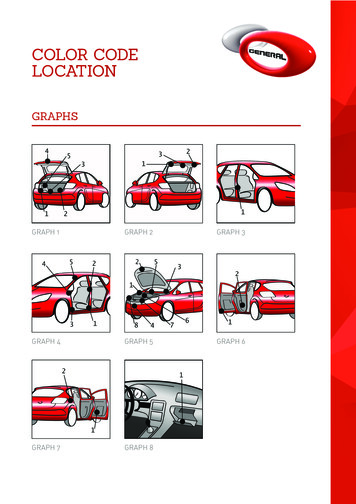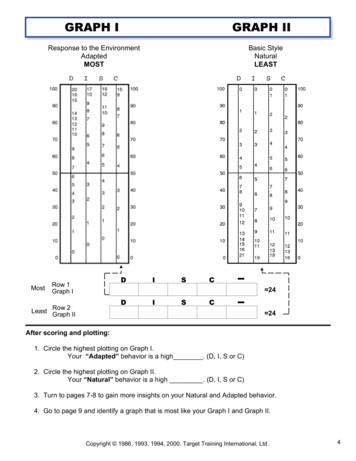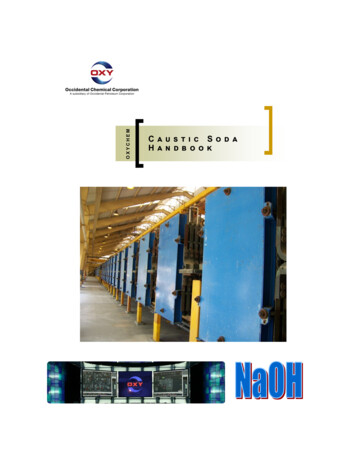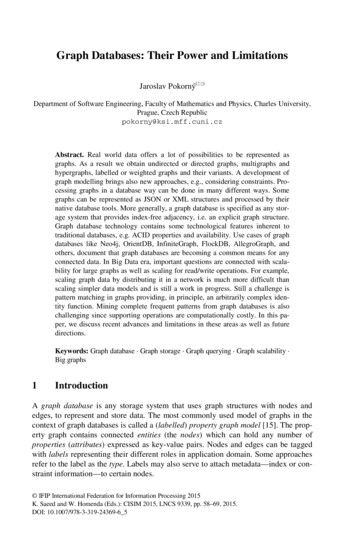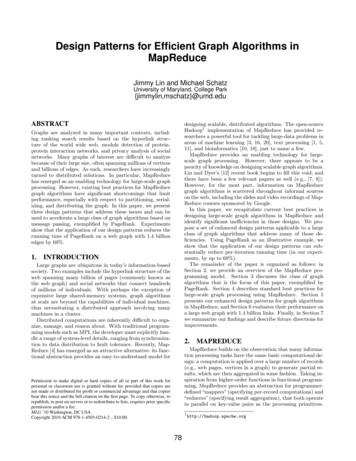
Transcription
Design Patterns for Efficient Graph Algorithms inMapReduceJimmy Lin and Michael SchatzUniversity of Maryland, College Park{jimmylin,mschatz}@umd.eduABSTRACTdesigning scalable, distributed algorithms. The open-sourceHadoop1 implementation of MapReduce has provided researchers a powerful tool for tackling large-data problems inareas of machine learning [3, 16, 20], text processing [1, 5,11], and bioinformatics [10, 18], just to name a few.MapReduce provides an enabling technology for largescale graph processing. However, there appears to be apaucity of knowledge on designing scalable graph algorithms.Lin and Dyer’s [12] recent book begins to fill this void, andthere have been a few relevant papers as well (e.g., [7, 8]).However, for the most part, information on MapReducegraph algorithms is scattered throughout informal sourceson the web, including the slides and video recordings of MapReduce courses sponsored by Google.In this paper, we recapitulate current best practices indesigning large-scale graph algorithms in MapReduce andidentify significant inefficiencies in those designs. We propose a set of enhanced design patterns applicable to a largeclass of graph algorithms that address many of those deficiencies. Using PageRank as an illustrative example, weshow that the application of our design patterns can substantially reduce per-iteration running time (in our experiments, by up to 69%).The remainder of the paper is organized as follows: inSection 2, we provide an overview of the MapReduce programming model. Section 3 discusses the class of graphalgorithms that is the focus of this paper, exemplified byPageRank. Section 4 describes standard best practices forlarge-scale graph processing using MapReduce. Section 5presents our enhanced design patterns for graph algorithmsin MapReduce, and Section 6 evaluates their performance ona large web graph with 1.4 billion links. Finally, in Section 7we summarize our findings and describe future directions forimprovements.Graphs are analyzed in many important contexts, including ranking search results based on the hyperlink structure of the world wide web, module detection of proteinprotein interaction networks, and privacy analysis of socialnetworks. Many graphs of interest are difficult to analyzebecause of their large size, often spanning millions of verticesand billions of edges. As such, researchers have increasinglyturned to distributed solutions. In particular, MapReducehas emerged as an enabling technology for large-scale graphprocessing. However, existing best practices for MapReducegraph algorithms have significant shortcomings that limitperformance, especially with respect to partitioning, serializing, and distributing the graph. In this paper, we presentthree design patterns that address these issues and can beused to accelerate a large class of graph algorithms based onmessage passing, exemplified by PageRank. Experimentsshow that the application of our design patterns reduces therunning time of PageRank on a web graph with 1.4 billionedges by 69%.1.INTRODUCTIONLarge graphs are ubiquitous in today’s information-basedsociety. Two examples include the hyperlink structure of theweb spanning many billion of pages (commonly known asthe web graph) and social networks that connect hundredsof millions of individuals. With perhaps the exception ofexpensive large shared-memory systems, graph algorithmsat scale are beyond the capabilities of individual machines,thus necessitating a distributed approach involving manymachines in a cluster.Distributed computations are inherently difficult to organize, manage, and reason about. With traditional programming models such as MPI, the developer must explicitly handle a range of system-level details, ranging from synchronization to data distribution to fault tolerance. Recently, MapReduce [4] has emerged as an attractive alternative: its functional abstraction provides an easy-to-understand model for2.MAPREDUCEMapReduce builds on the observation that many information processing tasks have the same basic computational design: a computation is applied over a large number of records(e.g., web pages, vertices in a graph) to generate partial results, which are then aggregated in some fashion. Taking inspiration from higher-order functions in functional programming, MapReduce provides an abstraction for programmerdefined “mappers” (specifying per-record computations) and“reducers” (specifying result aggregation), that both operatein parallel on key-value pairs as the processing primitives.Permission to make digital or hard copies of all or part of this work forpersonal or classroom use is granted without fee provided that copies arenot made or distributed for profit or commercial advantage and that copiesbear this notice and the full citation on the first page. To copy otherwise, torepublish, to post on servers or to redistribute to lists, requires prior specificpermission and/or a fee.MLG ’10 Washington, DC USACopyright 2010 ACM 978-1-4503-0214-2 . 10.00.178http://hadoop.apache.org
A αB βmapperppa 1D δmapperppb 2c 3combinera 1C γb 2F ζassociated with the same key may be highly skewed, nordoes it provide any locality between related keys.mapperppc 6a 5combinerc 9partitionerpE εpartitionerp3.mapperppc 2b 7combinera 5b 7c 2partitionerpThis paper assumes a standard definition of a directedgraph G (V, E) consisting of vertices V and directededges E, with N (vi ) {vj (vi , vj ) E} and N (vi ) {vj (vj , vi ) E} consisting of the set of all successors andpredecessors of vertex vi . Undirected graphs are also implicitly supported by replacing each undirected edge withtwo reciprocal directed edges. Both vertices and edges maybe annotated with additional metadata: as a simple example, in a social network where vertices represent individuals,there might be demographic information (e.g., age, gender,location) attached to the vertices and type information attached to the edges (e.g., indicating type of relationship suchas “friend” or “spouse”).We focus on a large class of iterative graph algorithms onsparse, directed graphs, where, at each iteration:c 8combinerc 8partitionerpShuffle and Sort: aggregate values by keysa1 5b2 7c2 9 8reducerreducerreducerX 5Y 7Z 9GRAPH ALGORITHMSFigure 1: Illustration of MapReduce: mappers areapplied to input records, which generate intermediate results that are aggregated by reducers. Localaggregation is accomplished by combiners, and partitioners determine to which reducer intermediatedata are shuffled.1. computations occur at every vertex as a function of thevertex’s internal state and its local graph structure;and2. partial results in the form of arbitrary messages are“passed” via directed edges to each vertex’s neighbors;and, finallyThe mapper is applied to every input key-value pair to generate an arbitrary number of intermediate key-value pairs.The reducer is then applied to all values associated with thesame intermediate key to generate an arbitrary number offinal key-value pairs as output. This two-stage processingstructure is illustrated in Figure 1.Under the MapReduce programming model, a developerneeds only to provide implementations of the mapper andreducer. On top of a distributed file system [6], the executionframework (i.e., “runtime”) transparently handles all otheraspects of execution on clusters ranging from a few to afew thousand cores. It is responsible, among other things,for scheduling (moving code to data), handling faults, andthe large distributed sorting and shuffling problem betweenthe map and reduce phases whereby intermediate key-valuepairs must be grouped by key.As an optimization, MapReduce supports the use of “combiners”, which are similar to reducers except that they operate directly on the output of mappers; one can think of themas “mini-reducers”. Combiners operate in isolation on eachnode in the cluster and cannot use partial results from othernodes. Since the output of mappers (i.e., intermediate keyvalue pairs) must eventually be shuffled to the appropriatereducer over the network, combiners allow a programmer toaggregate partial results, thus reducing network traffic. Incases where an operation is both associative and commutative, reducers can directly serve as combiners, although ingeneral they are not interchangeable.The final component of MapReduce is the “partitioner”,which is responsible for dividing up the intermediate keyspace and assigning intermediate key-value pairs to reducers. The default partitioner computes the hash value of thekey modulo the number of reducers. Although with anyreasonable hash function the partitioner will divide up theintermediate key space roughly evenly, this does not guarantee good load balance because the distribution of values3. computations occur at every vertex based on incomingpartial results, potentially altering the vertex’s internalstate.Typically, such algorithms iterate some number of times,using graph state from the previous iteration as input to thenext iteration, until some stopping criterion is met.A prototypical example of the above class of graph algorithms is PageRank [2, 15], a well-known algorithm forcomputing the importance of vertices in a graph based onits topology. For each vertex vi in the graph, PageRankcomputes the value Pr(vi ) representing the likelihood thata random walk of the graph will arrive at vertex vi . The likelihood value of a node is primarily derived from the topologyof the graph, but the computation also includes a dampingfactor d, which allows for periodic random jumps to anyother node in the graph. PageRank can be computed algebraically for small graphs, but is generally computed iteratively over multiple timesteps t using the power method:(Pr(vi ; t) 1/ V P1 d d vj N (vi ) V Pr(vj ;t 1) N (vj ) if t 0if t 0(1)The algorithm iterates until either a user defined maximumnumber of iterations is reached, or the the values sufficientlyconverge. One common convergence criterion is:X Pr(vi ; t) Pr(vi ; t 1) (2)PageRank was originally developed to rank the importance of web pages based on the hyperlink structure of theweb, but can be applied to rank vertices by their topologywithin any graph. It also forms the basis for many significantgraph analysis algorithms [9].79
1: class Mapper2:method Map(id n, vertex N )3:p N.PageRank/ N.AdjacencyList 4:Emit(id n, vertex N )5:for all nodeid m N.AdjacencyList do6:Emit(id m, value p)In this paper, we primarily focus on PageRank as an exemplar of the class of graph algorithms we are interested in. Inparticular, the power method as formulated in (1) requiresonly that the local topology and the uniform damping factorare considered at each step, making it especially well suitedto parallel computing. However, it is important to recognizethat our techniques are equally applicable to a large numberof algorithms that take the form discussed above: specific examples include parallel breadth-first search, label propagation, other topology-based vertex ranking algorithms such asHITS [9], a number of graph-based approaches for DNA sequence assembly [17, 21], and the analysis of protein-proteininteraction networks [13, 14].4.1: class Reducer2:method Reduce(id m, [p1 , p2 , . . .])3:M 4:for all p [p1 , p2 , . . .] do5:if IsVertex(p) then6:M p7:else8:s s p9:M.PageRank s10:Emit(id m, vertex M )BASIC IMPLEMENTATIONThe original MapReduce paper [4] described several dataintensive applications for the programming model, includingword count, distributed grep, and inverted index construction, but unfortunately did not discuss graph algorithms.To our knowledge, the first reasonably detailed explanationof MapReduce graph algorithms can be traced to lectureslides and video recordings of courses sponsored by Googlein 2007.2 The materials described implementations of parallel breath-first search and PageRank: these have become thede facto best practices for MapReduce graph processing. Inthis section, we provide an overview of those methods, whichwe will refer to as the basic implementation.4.1Figure 2: Pseudo-code for simplified PageRank inMapReduce. In the map phase we evenly divide upeach vertex’s PageRank mass and pass each piecealong outgoing edges to neighbors. In the reducephase PageRank contributions are summed up ateach destination vertex. Each MapReduce job corresponds to one iteration of the algorithm.the routing of the messages. In the reducer, all messagesthat have the same key (i.e., same destination vertex id) arrive together, and another computation is performed, whichcorresponds to Step (3).There is one critical detail necessary for the above approach to work: the mapper must also emit the vertex structure (i.e., the input value) with the vertex id as the key. Thispasses the vertex structure to the reduce phase, where it isreunited with messages destined for that vertex—so that thereducer can update the vertex’s internal state and write outthe revised graph to disk. Without this step, there wouldbe no way to perform multiple iterations, since we wouldhave lost the graph structure. Thus, there are two distinctdata flows in the basic implementation of graph algorithmsin MapReduce: one corresponding to the flow of messagesfrom source to destination vertices along graph edges, andthe other corresponding to the shuffling of the graph structure itself.As a concrete example, pseudo-code for a MapReduce implementation of PageRank is provided in Figure 2. This is asimplified implementation that does not handle the dampingfactor and dangling nodes (i.e., nodes without neighbors),but suffices to illustrate the key points. For interested readers, Lin and Dyer [12] provide the full implementation. Inline (4) of the mapper we pass along the graph structure. Inlines (5) and (6) of the mapper we distribute an equal shareof the vertex’s current PageRank value to its neighbors; messages are floating point values, representing PageRank masscontributions.The reducer receives a number of values associated withthe same key. It must differentiate the messages (PageRankmass contributions) from the vertex structure, which is accomplished in line (5) of the reducer pseudo-code.3 PageRank contributions from incoming edges to a vertex areMessage PassingComputations in MapReduce operate on input key-valuepairs; both keys and values can be primitive types (integers,strings, etc.) or arbitrarily complex records (e.g., tuples withnested structure). For graph processing, it is most naturalto adopt an adjacency list representation: graphs are serialized into key-value pairs using the identifier of the vertex asthe key, and the record comprising the vertex’s structure asthe value. Typically, the value would include the adjacencylist N (vi ) (possibly with metadata attached to the edges),metadata attached to the vertex, as well as the vertex’s internal state (e.g., its current PageRank value). By virtue ofthe underlying distributed file system, the key-value pairscomprising the graph will be divided into blocks and spreadacross the local disks of nodes in the cluster. Vertices are assigned arbitrarily to different blocks using the default HashPartitioner, but the physical layout of the graph structureon disk can be controlled by using a custom partitioner orlabeling scheme. We return to this point in Section 5.3.MapReduce is well suited to the class of graph algorithmsdiscussed in Section 3: the shuffle and sort phase can beexploited to propagate information between vertices usinga form of distributed message passing. The canonical approach is to map over the key-value pairs comprising thegraph, corresponding to Step (1) where computations occur at every vertex using the local graph structure, vertexmetadata, and additional vertex state contained in the serialized graph vertices. The results of the computation arearbitrary messages to be passed to each vertex’s neighbors.This is accomplished by having mappers emit intermediatekey-value pairs where the key is the destination vertex idand the value is the message. This corresponds to Step (2),using the shuffle and sort phase of MapReduce to perform23In practice, we create a complex value that contains anindicator variable, specifying its status either as a messageor the vertex structure.http://code.google.com/edu/parallel/80
1: class Combiner2:method Combine(id m, [p1 , p2 , . . .])3:M 4:for all p [p1 , p2 , . . .] do5:if IsVertex(p) then6:Emit(id m, vertex p)7:else8:s s p9:Emit(nid m, value p)1: class Mapper2:method Initialize3:H new AssociativeArray4:method Map(id n, vertex N )5:p N.PageRank/ N.AdjacencyList 6:Emit(id n, vertex N )7:for all id m N.AdjacencyList do8:H{m} H{m} p9:method Close10:for all id n H do11:Emit(id n, value H{n})Figure 3: Combiner pseudo-code for PageRank inMapReduce. The combiner aggregates partial PageRank contributions by destination vertex and passesthe graph structure along.Figure 4: Mapper pseudo-code for PageRank inMapReduce that implements the in-mapper combining design pattern.summed, and in line (9) of the reducer pseudo-code, thevertex’s PageRank is updated. Finally, the updated graphis serialized and written to the distributed file system. Thiscompletes one iteration of PageRank. The output is thenready to serve as input to another MapReduce job representing the next iteration. Typically, a driver program examinesresults between iterations to check for convergence.4.2Building on this, we present three enhanced design patternsthat address significant inefficiencies in the basic implementation: (1) costs associated with materializing intermediatekey-value pairs when using combiners, (2) costs associatedwith shuffling the graph structure from the mappers to thereducers, and (3) costs associated with topology-oblivioushash partitioning of vertices.Local Aggregation5.1Although it is not always the case, mapper and reducercomputations for the class of graph algorithms we are interested in are often very simple. In PageRank, for example, the mappers perform a simple division to “divy up”the PageRank mass, and the reducers sum incoming PageRank contributions. Therefore, the algorithm running timeis dominated by shuffling large amounts of data across thenetwork between the map and reduce stages of processing:both messages passed along graph edges and the graph structure itself. Because of this, any reductions in the amountof data shuffled across the network increases the speed of aMapReduce algorithm.Combiners in MapReduce are responsible for performinglocal aggregation (i.e., a partial reduce on map output),which reduces the amount of data that must be shuffledacross the network. Clearly, they are only effective if thereare multiple key-value pairs with the same key computedon the same machine that can be aggregated. In practice,combiners often yield dramatic reductions in algorithm running time due to decreased network traffic. The combinerfor PageRank is shown in Figure 3. If it encounters messagesdestined for the same vertex, it sums up those partial PageRank values and emits the aggregate, while the graph structure is simply “passed along” to the reducer. For PageRank,combiners are especially effective for reducing the number ofmessages passed to vertices with high in-degrees. This hasthe additional effect of reducing the skew in the running timeof reducers. PageRank is typically run on graphs whose vertex in-degrees follow power law distributions (e.g., the webgraph): since reducer computations are proportional to thevertex’s in-degree (i.e., number of incoming messages), somevertices take much longer to process than others. Combinerssignificantly cut down on the number of messages destinedfor vertices with high in-degrees.5.In-Mapper CombiningAlthough combiners provide a mechanism for local aggregation in MapReduce, there are two major disadvantageswith using them. First, combiner semantics is underspecified in MapReduce. For example, Hadoop makes no guarantees on how many times the combiner is applied, or that it iseven applied at all. The combiner is provided as a semanticspreserving optimization to the execution framework, whichhas the option of using, perhaps multiple times, or not atall. Such indeterminism may be unacceptable.Second, combiners reduce the amount of intermediate datashuffled across the network, but don’t actually reduce thenumber of key-value pairs that are emitted by the mappersin the first place. With Hadoop combiners, intermediatekey-value pairs are materialized in an in-memory buffer andthen “spilled” to local disk. Only in subsequent merge passesof on-disk key-value pairs are combiners executed. This process involves unnecessary object creation and destruction,and furthermore, object serialization and deserialization.To address these downsides, Lin and Dyer proposed the“in-mapper combining” design pattern [12], which exploitsthe fact that mappers can preserve state across the processing of multiple input key-value pairs and defer emissionof intermediate data until all input records have been processed. Understanding this pattern requires a few additionaldetails on the life cycle of mappers in Hadoop. A mapperobject is created (by the execution framework) to process ablock of input, and the object’s Map method is repeatedlycalled to process input key-value pairs. Hadoop also provides two API hooks, which we refer to as Initialize andClose, that allow user-specified code to execute before anykey-value pairs are processed and after all key-value pairsare processed, respectively.Figure 4 illustrates the in-mapper combining pattern applied to the PageRank algorithm. Prior to processing input,the mapper initializes an associative array (i.e., map) foraccumulating partial PageRank scores, with the destinationvertex id as the key. When mapping over graph vertices, thisassociative array is updated with partial PageRank contri-ALGORITHM OPTIMIZATIONSThe previous section recapitulates existing best practicesfor designing large-scale graph algorithms in MapReduce.81
1: class Reducer2:method Initialize3:P.OpenGraphPartition()4:method Reduce(id m, [p1 , p2 , . . .])5:repeat6:(id n, vertex N ) P.Read()7:if n 6 m then8:Emit(id n, vertex N )9:until n m10:for all p values [p1 , p2 , . . .] do11:s s p12:N.PageRank s13:Emit(id n, vertex N )butions. Intermediate key-value pairs are not emitted untilall inputs have been processed. This design pattern is socalled because, in effect, we are moving the functionality ofthe combiner inside the mapper itself. We eliminate multiplemessages with the same destination vertex that would havebeen otherwise emitted by the mapper, and instead onlyemit a single message that contains an aggregated value.5.2SchimmyIn the basic graph algorithm implementation described inSection 4, there are two separate dataflows from mappersto reducers: (1) messages passed from source to destinationvertices and (2) the graph structure itself. By emitting eachvertex’s structure in the mapper, the appropriate reducer receives messages destined for that vertex along with its structure. This allows the reducer to perform a computation andto update the graph structure, which is written to disk forthe next iteration.Shuffling the graph structure between the map and reduce phases is highly inefficient, especially since the algorithms we are interested in are iterative and require multiple MapReduce jobs. Because the graph structure includesmetadata and other state information, it is frequently muchlarger than the messages that are passed along graph edges.As we previously discussed, network traffic dominates theexecution time, so reductions in the amount of intermediate data are highly desirable. Furthermore, in many algorithms the topology of the graph and associated metadata donot change (only each vertex’s state does), making repeatedshuffling of the graph structure even more wasteful. To address this significant shortcoming of the basic implementation, we introduce a novel design pattern called “schimmy”that addresses this inefficiency. As far as we know, this is thefirst elucidation of this general approach to graph processingfor MapReduce that we are aware of.The intuition behind the schimmy design pattern is theparallel merge join, which is a well known join technique inthe database community [19]. Let’s say we wish to join tworelations, S and T , and the tuples in both relations weresorted by the join key. If this were the case, we can performa join by scanning through both relations simultaneously.This process can be parallelized by partitioning and sortingboth relations in the same way. For example, suppose Sand T were both divided into ten files, partitioned in thesame manner by the join key. Further suppose that in eachfile, the tuples were sorted by the join key. In this case, wesimply need to merge join the first file of S with the first fileof T , the second file with S with the second file of T , etc.;these merge joins could happen in parallel.This method can be applied in graph processing as follows:suppose the input key-value pairs representing the graphstructure were partitioned into n files (i.e., parts), such thatG G1 G2 . . . Gn , and within each file, vertices aresorted by vertex id. Now let us use the same partition function as the partitioner in our MapReduce graph algorithm,and set the number of reducers equal to the number of inputfiles (i.e., parts). This guarantees that the intermediate keys(vertex ids) processed by reducer R1 are exactly the sameas the vertex ids in G1 ; the same for R2 and G2 , R3 andG3 , and so on up to Rn and Gn . Furthermore, since theMapReduce execution framework guarantees that intermediate keys are processed in sorted order, the correspondingRn and Gn parts are sorted in exactly the same manner.Figure 5: Reducer pseudo-code for PageRank inMapReduce using the schimmy design pattern toavoid shuffling the graph structure.The intermediate keys in Rn represent messages passed toeach vertex, and the Gn key-value pairs comprise the graphstructure. Therefore, a parallel merge join between R andG suffices to unite the result of computations based on messages passed to a vertex and the vertex’s structure, thusenabling the algorithm to update the vertex’s internal state.We have eliminated the need to shuffle G across the network.With the MapReduce implementation of PageRank using the schimmy design pattern, we no longer need to emitthe graph structure in the map phase of processing. Themapper remains the same as the pseudo-code in Figure 2,with the exception that line (4) is removed (or, alternatively,one could take advantage of in-mapper combining as shownin Figure 4). The corresponding reducer is shown in Figure 5. In the initialization API hook, the reducer opensthe file containing the graph partition corresponding to theintermediate keys that are to be processed by the reducer.As the reducer is processing messages passed to each vertex in the Reduce method, it advances the file stream inthe graph structure until the corresponding vertex’s structure is found. Once the reduce computation is complete (asimple sum), the vertex’s state is updated with the revisedPageRank value and written back to disk. The partitionerensures consistent partitioning of the graph structure fromiteration to iteration.When the reducer processes intermediate key-value pairs,those data are read from the local disks of the cluster nodesrunning the reducers. Files containing the graph structure,on the other hand, reside on the underlying distributed filesystem (HDFS for Hadoop). Since the MapReduce execution framework arbitrarily assigns reducers to cluster nodes,accessing vertex data structures will almost always involveremote reads (i.e., data streamed off the local disk of anothercluster node). This is a potential bottleneck, but experimental results show that these remote reads are not a significantlimitation.5.3Range PartitioningAs previously mentioned, the distributed filesystem underlying MapReduce splits large graphs into multiple blocksstored on different machines in the cluster. This allows different mappers to execute in parallel on separate, locallystored portions of the graph. By default, the partitioning ofthe graph uses an arbitrary hash function of the vertex id,82
effectively assigning a particular vertex to a particular blockwith uniform probability. The hash function is effective forensuring the different blocks have approximately the samenumber of vertices, and consequently should require approximately the same amount of time to process. However, thedefault HashPartitioner has no consideration for the topology of the graph, so the probability that a vertex and itsneighbors are in the same block is purely a function of thesize of each block, even if the graph has very regular structure or multiple independent connected components.For graph processing it is highly advantageous for adjacent vertices to be stored in the same block, so that anymessages passing between them can be processed in memoryor at least without any network traffic. The general problemof partitioning a graph into multiple blocks of roughly equalsize such that the intra-block links are maximized and theinter-block links are minimized is computationally quite difficult, but real world graphs often have properties that canbe used to effectively approximate this partitioning.In particular, web pages within a given domain are muchmore densely hyperlinked than pages across domains. Thus,if pages from the same domain are assigned to the sameblock, we can achieve a reasonably good partitioning of theweb graph. This insight can be utilized in MapReduce byimplementing a custom partitioner that hashes the domainname of each URL. However, this would require storing theURL of vertices, which is not desirable since an integer vertex id is far more compact. Nevertheless, we can still leverage this insight if web pages from the same do
designing large-scale graph algorithms in MapReduce and identify signi cant ine ciencies in those designs. We pro-pose a set of enhanced design patterns applicable to a large class of graph algorithms that address many of those de- ciencies. Using PageRank as an illustrative example, we show that the application of our design patterns can sub-
